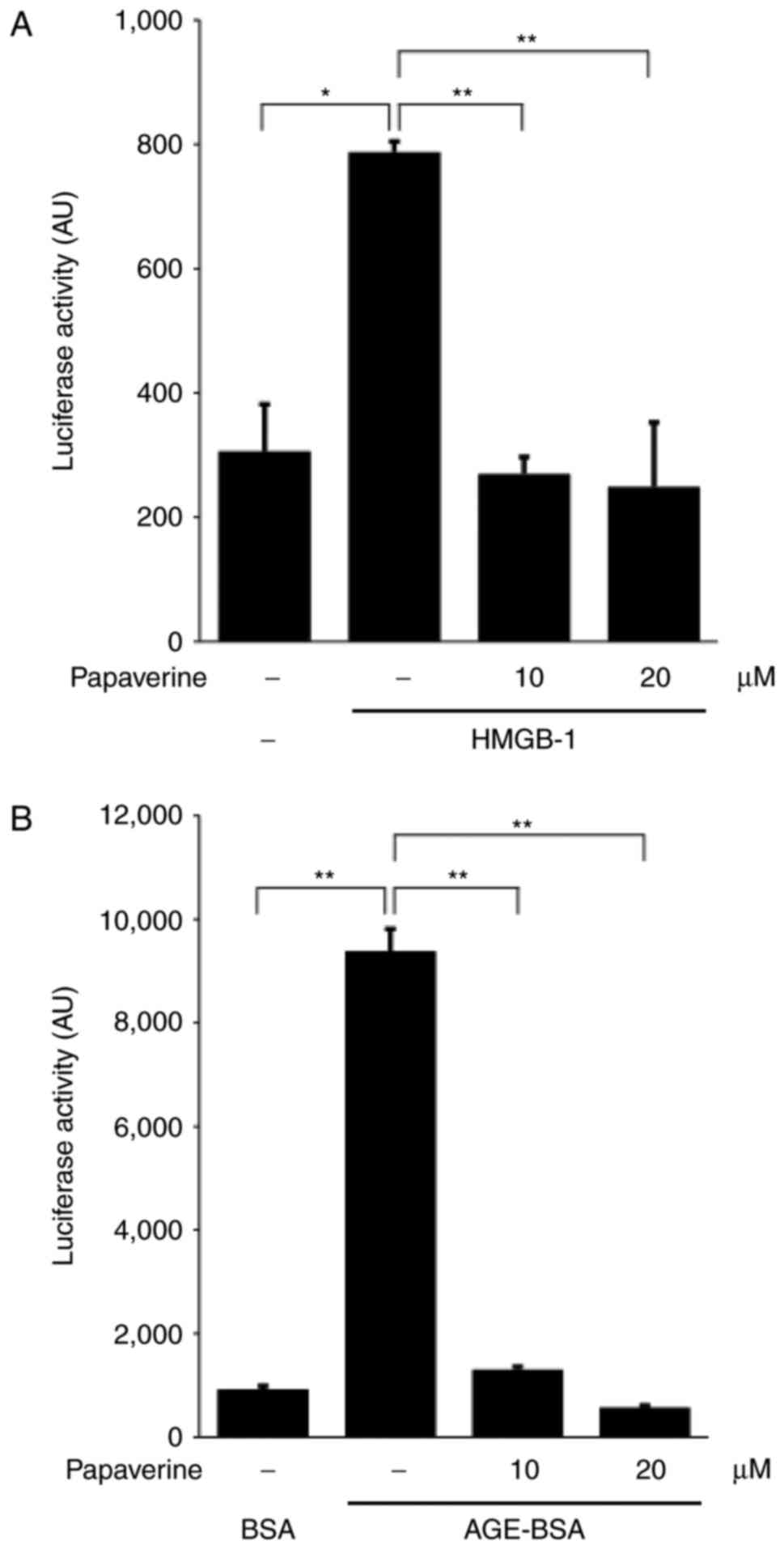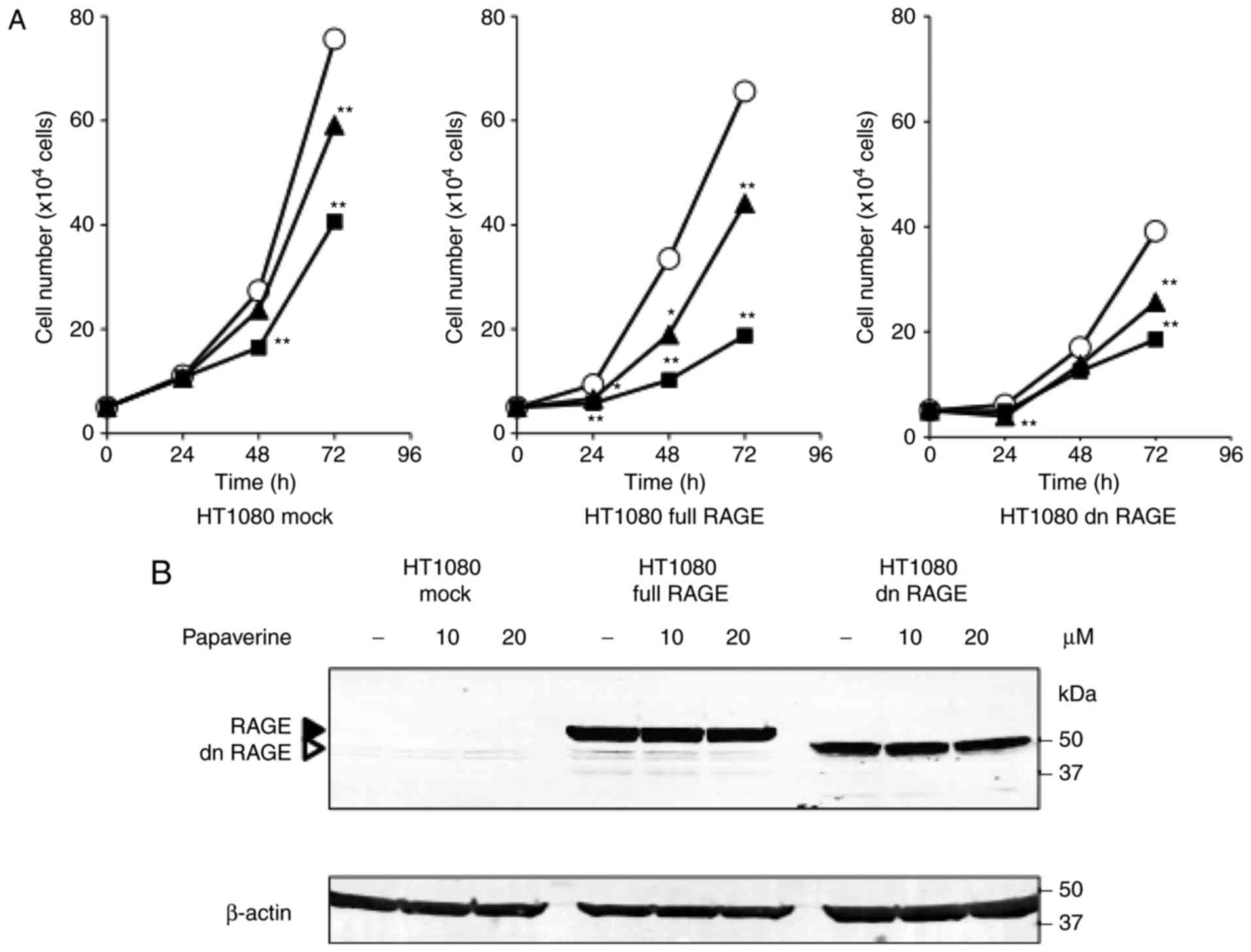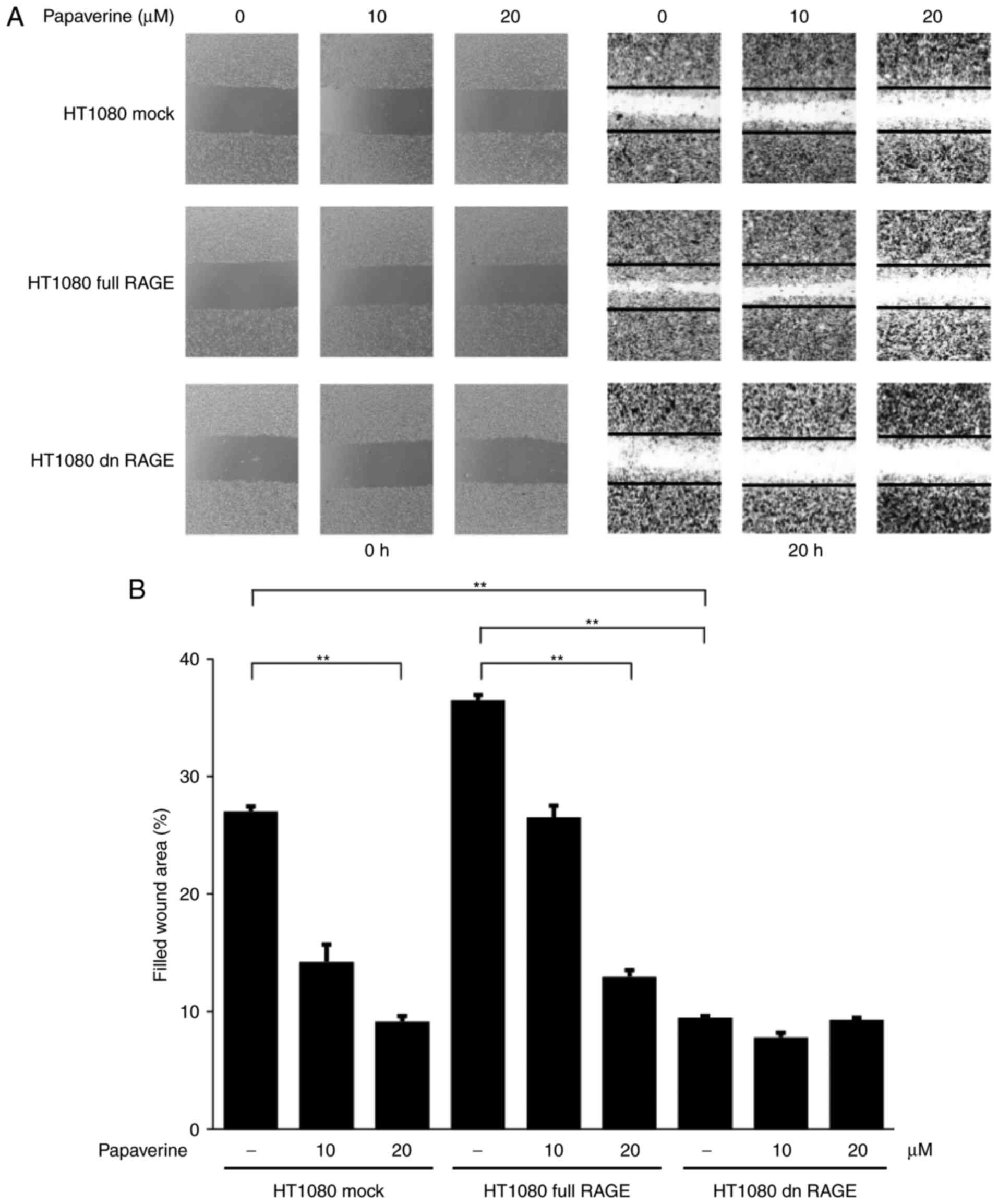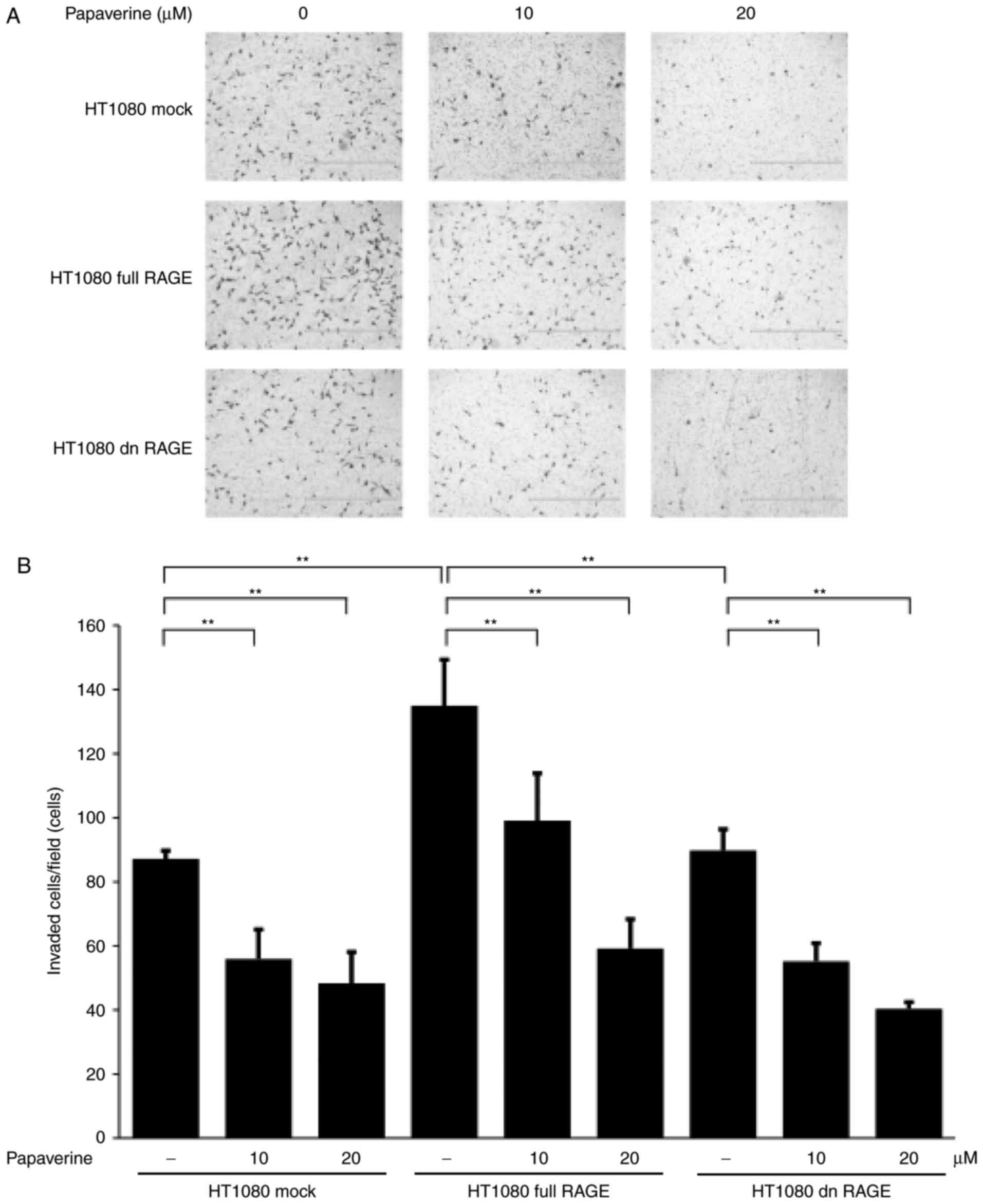|
1
|
Schmidt AM, Vianna M, Gerlach M, Brett J,
Ryan J, Kao J, Esposito C, Hegarty H, Hurley W, Clauss M, et al:
Isolation and characterization of two binding proteins for advanced
glycosylation end products from bovine lung which are present on
the endothelial cell surface. J Biol Chem. 267:14987–14997.
1992.PubMed/NCBI
|
|
2
|
Hofmann MA, Drury S, Fu C, Qu W, Taguchi
A, Lu Y, Avila C, Kambham N, Bierhaus A, Nawroth P, et al: RAGE
mediates a novel proinflammatory axis: A central cell surface
receptor for S100/calgranulin polypeptides. Cell. 97:889–901. 1999.
View Article : Google Scholar : PubMed/NCBI
|
|
3
|
Yamamoto Y, Harashima A, Saito H,
Tsuneyama K, Munesue S, Motoyoshi S, Han D, Watanabe T, Asano M,
Takasawa S, et al: Septic shock is associated with receptor for
advanced glycation endproducts (RAGE) ligation of LPS. J Immunol.
186:3248–3257. 2011. View Article : Google Scholar : PubMed/NCBI
|
|
4
|
He M, Kubo H, Morimoto K, Fujino N, Suzuki
T, Takahasi T, Yamada M, Yamaya M, Maekawa T, Yamamoto Y and
Yamamoto H: Receptor for advanced glycation end products binds to
phosphatidylserine and assists in the clearance of apoptotic cells.
EMBO Rep. 12:358–364. 2011. View Article : Google Scholar : PubMed/NCBI
|
|
5
|
Yan SD, Chen X, Fu J, Chen M, Zhu H, Roher
A, Slattery T, Zhao L, Nagashima M, Morser J, et al: RAGE and
amyloid-beta peptide neurotoxicity in Alzheimer's disease. Nature.
382:685–691. 1996. View
Article : Google Scholar : PubMed/NCBI
|
|
6
|
Hori O, Brett J, Slattery T, Cao R, Zhang
J, Chen J, Nagashima M, Lundh ER, Vijay S, Nitecki D, et al: The
receptor for advanced glycation end products (RAGE) is a cellular
binding site for amphoterin: Mediation of neurite outgrowth and
co-expression of rage and amphoterin in the developing nervous
system. J Biol Chem. 270:25752–25761. 1995. View Article : Google Scholar : PubMed/NCBI
|
|
7
|
Yamamoto Y, Kato I, Doi T, Yonekura H,
Ohashi S, Takeuchi M, Watanabe T, Yamagishi S, Sakurai S, Takasawa
S, et al: Development and prevention of advanced diabetic
nephropathy in RAGE-overexpressing mice. J Clin Invest.
108:261–268. 2001. View
Article : Google Scholar : PubMed/NCBI
|
|
8
|
Schmidt AM, Yan SD, Yan SF and Stern DM:
The multiligand receptor RAGE as a progression factor amplifying
immune and inflammatory responses. J Clin Invest. 108:949–955.
2001. View Article : Google Scholar : PubMed/NCBI
|
|
9
|
Sims GP, Rowe DC, Rietdijk ST, Herbst R
and Coyle AJ: HMGB1 and RAGE in inflammation and cancer. Annu Rev
Immunol. 28:367–388. 2010. View Article : Google Scholar : PubMed/NCBI
|
|
10
|
Takeuchi A, Yamamoto Y, Munesue S,
Harashima A, Watanabe T, Yonekura H, Yamamoto H and Tsuchiya H: Low
molecular weight heparin suppresses receptor for advanced glycation
end products-mediated expression of malignant phenotype in human
fibrosarcoma cells. Cancer Sci. 104:740–749. 2013. View Article : Google Scholar : PubMed/NCBI
|
|
11
|
Kuniyasu H, Oue N, Wakikawa A, Shigeishi
H, Matsutani N, Kuraoka K, Ito R, Yokozaki H and Yasui W:
Expression of receptors for advanced glycation end-products (RAGE)
is closely associated with the invasive and metastatic activity of
gastric cancer. J Pathol. 196:163–170. 2002. View Article : Google Scholar : PubMed/NCBI
|
|
12
|
Fuentes MK, Nigavekar SS, Arumugam T,
Logsdon CD, Schmidt AM, Park JC and Huang EH: RAGE activation by
S100P in colon cancer stimulates growth, migration, and cell
signaling pathways. Dis Colon Rectum. 50:1230–1240. 2007.
View Article : Google Scholar : PubMed/NCBI
|
|
13
|
Onyeagucha BC, Mercado-Pimentel ME,
Hutchison J, Flemington EK and Nelson MA: S100P/RAGE signaling
regulates microRNA-155 expression via AP-1 activation in colon
cancer. Exp Cell Res. 319:2081–2090. 2013. View Article : Google Scholar : PubMed/NCBI
|
|
14
|
Mercado-Pimentel ME, Onyeagucha BC, Li Q,
Pimentel AC, Jandova J and Nelson MA: The S100P/RAGE signaling
pathway regulates expression of microRNA-21 in colon cancer cells.
FEBS Lett. 589:2388–2393. 2015. View Article : Google Scholar : PubMed/NCBI
|
|
15
|
Ishiguro H, Nakaigawa N, Miyoshi Y,
Fujinami K, Kubota Y and Uemura H: Receptor for advanced glycation
end products (RAGE) and its ligand, amphoterin are overexpressed
and associated with prostate cancer development. Prostate.
64:92–100. 2005. View Article : Google Scholar : PubMed/NCBI
|
|
16
|
Kwak T, Drews-Elger K, Ergonul A, Miller
PC, Braley A, Hwang GH, Zhao D, Besser A, Yamamoto Y, Yamamoto H,
et al: Targeting of RAGE-ligand signaling impairs breast cancer
cell invasion and metastasis. Oncogene. 36:1559–1572. 2017.
View Article : Google Scholar : PubMed/NCBI
|
|
17
|
Zhang Q, Jin Y, Zhao CF, Wang WJ and Liu
GY: Receptor for advanced glycation end-products (RAGE) is
overexpressed in human osteosarcoma and promotes the proliferation
of osteosarcoma U-2OS cells in vitro. Genet Mol Res. 15:2016.
|
|
18
|
Sakai J, Yoshimori A, Nose Y, Mizoroki A,
Okita N, Takasawa R and Tanuma S: Structure-based discovery of a
novel non-peptidic small molecular inhibitor of caspase-3. Bioorg
Med Chem. 16:4854–4859. 2008. View Article : Google Scholar : PubMed/NCBI
|
|
19
|
Kukovetz WR and Pöch G: Inhibition of
cyclic-3′, 5′-nucleotide-phosphodiesterase as a possible mode of
action of papaverine and similarly acting drugs. Naunyn
Schmiedebergs Arch Pharmakol. 267:189–194. 1970. View Article : Google Scholar : PubMed/NCBI
|
|
20
|
Iguchi M, Nakajima T, Hisada T, Sugimoto T
and Kurachi Y: On the mechanism of papaverine inhibition of the
voltage-dependent Ca++ current in isolated smooth muscle
cells from the guinea pig trachea. J Pharmacol Exp Ther.
263:194–200. 1992.PubMed/NCBI
|
|
21
|
Myint KM, Yamamoto Y, Doi T, Kato I,
Harashima A, Yonekura H, Watanabe T, Shinohara H, Takeuchi M,
Tsuneyama K, et al: RAGE control of diabetic nephropathy in a mouse
model: Effects of RAGE gene disruption and administration of
low-molecular weight heparin. Diabetes. 55:2510–2522. 2006.
View Article : Google Scholar : PubMed/NCBI
|
|
22
|
Huttunen HJ, Fages C and Rauvala H:
Receptor for advanced glycation end products (RAGE)-mediated
neurite outgrowth and activation of NF-κB require the cytoplasmic
domain of the receptor but different down signaling pathways. J
Biol Chem. 274:19919–19924. 1999. View Article : Google Scholar : PubMed/NCBI
|
|
23
|
Huttunen HJ, Fages C, Kuja-Panula J,
Ridley AJ and Rauvala H: Receptor for advanced glycation end
products-binding COOH-terminal motif of amphoterin inhibits
invasive migration and metastasis. Cancer Res. 62:4805–4811.
2002.PubMed/NCBI
|
|
24
|
Wajsman Z, Williams P and Murphy GP: A
study of the effect of papaverine in neuroblastoma using the
experimental C1300 murine system. Oncology. 35:1–4. 1978.
View Article : Google Scholar : PubMed/NCBI
|
|
25
|
Wolf S, Haase-Kohn C, Lenk J, Hoppmann S,
Bergmann R, Steinbach J and Pietzsch J: Expression, purification
and fluorine-18 radiolabeling of recombinant S100A4: A potential
probe for molecular imaging of receptor for advanced glycation
endproducts in vivo? Amino Acids. 41:809–820. 2011. View Article : Google Scholar : PubMed/NCBI
|
|
26
|
Leclerc E, Fritz G, Weibel M, Heizmann CW
and Galichet A: S100B and S100A6 differentially modulate cell
survival by interacting with distinct RAGE (receptor for advanced
glycation end products) immunoglobulin domains. J Biol Chem.
282:31317–31331. 2007. View Article : Google Scholar : PubMed/NCBI
|
|
27
|
Wolf R, Howard OM, Dong HF, Voscopoulos C,
Boeshans K, Winston J, Divi R, Gunsior M, Goldsmith P, Ahvazi B, et
al: Chemotactic activity of S100A7 (Psoriasin) is mediated by the
receptor for advanced glycation end products and potentiates
inflammation with highly homologous but functionally distinct
S100A15. J Immunol. 181:1499–1506. 2008. View Article : Google Scholar : PubMed/NCBI
|
|
28
|
Jin Q, Chen H, Luo A, Ding F and Liu Z:
S100A14 stimulates cell proliferation and induces cell apoptosis at
different concentrations via receptor for advanced glycation end
products (RAGE). PLoS One. 6:e193752011. View Article : Google Scholar : PubMed/NCBI
|
|
29
|
Padilla L, Dakhel S and Hernández JL: S100
to receptor for advanced glycation end-products binding assay:
Looking for inhibitors. Biochem Biophys Res Commun. 446:404–409.
2014. View Article : Google Scholar : PubMed/NCBI
|
|
30
|
Chen X, Zhang L, Zhang IY, Liang J, Wang
H, Ouyang M, Wu S, da Fonseca AC, Weng L, Yamamoto Y, et al: RAGE
expression in tumor-associated macrophages promotes angiogenesis in
glioma. Cancer Res. 74:7285–7297. 2014. View Article : Google Scholar : PubMed/NCBI
|
|
31
|
Khorramdelazad H, Bagheri V, Hassanshahi
G, Karami H, Moogooei M, Zeinali M and Abedinzadeh M: S100A12 and
RAGE expression in human bladder transitional cell carcinoma: A
role for the ligand/RAGE axis in tumor progression? Asian Pac J
Cancer Prev. 16:2725–2729. 2015. View Article : Google Scholar : PubMed/NCBI
|
|
32
|
Meghnani V, Wagh A, Indurthi VS, Koladia
M, Vetter SW, Law B and Leclerc E: The receptor for advanced
glycation end products influences the expression of its S100
protein ligands in melanoma tumors. Int J Biochem Cell Biol.
57:54–62. 2014. View Article : Google Scholar : PubMed/NCBI
|
|
33
|
Kostova N, Zlateva S, Ugrinova I and
Pasheva E: The expression of HMGB1 protein and its receptor RAGE in
human malignant tumors. Mol Cell Biochem. 337:251–258. 2010.
View Article : Google Scholar : PubMed/NCBI
|
|
34
|
Sparvero LJ, Asafu-Adjei D, Kang R, Tang
D, Amin N, Im J, Rutledge R, Lin B, Amoscato AA, Zeh HJ and Lotze
MT: RAGE (Receptor for Advanced Glycation Endproducts), RAGE
ligands, and their role in cancer and inflammation. J Transl Med.
7:172009. View Article : Google Scholar : PubMed/NCBI
|
|
35
|
Wu R, Duan L, Cui F, Cao J, Xiang Y, Tang
Y and Zhou L: S100A9 promotes human hepatocellular carcinoma cell
growth and invasion through RAGE-mediated ERK1/2 and p38 MAPK
pathways. Exp Cell Res. 334:228–238. 2015. View Article : Google Scholar : PubMed/NCBI
|
|
36
|
Iotzova-Weiss G, Dziunycz PJ, Freiberger
SN, Läuchli S, Hafner J, Vogl T, French LE and Hofbauer GF:
S100A8/A9 stimulates keratinocyte proliferation in the development
of squamous cell carcinoma of the skin via the receptor for
advanced glycation-end products. PLoS One. 10:e01209712015.
View Article : Google Scholar : PubMed/NCBI
|
|
37
|
Hudson BI, Kalea AZ, Del Mar Arriero M,
Harja E, Boulanger E, D'Agati V and Schmidt AM: Interaction of the
RAGE cytoplasmic domain with diaphanous-1 is required for
ligand-stimulated cellular migration through activation of Rac1 and
Cdc42. J Biol Chem. 283:34457–34468. 2008. View Article : Google Scholar : PubMed/NCBI
|
|
38
|
Kalea AZ, See F, Harja E, Arriero M,
Schmidt AM and Hudson BI: Alternatively spliced RAGEv1 inhibits
tumorigenesis through suppression of JNK signaling. Cancer Res.
70:5628–5638. 2010. View Article : Google Scholar : PubMed/NCBI
|
|
39
|
Taguchi A, Blood DC, del Toro G, Canet A,
Lee DC, Qu W, Tanji N, Lu Y, Lalla E, Fu C, et al: Blockade of
RAGE-amphoterin signalling suppresses tumour growth and metastases.
Nature. 405:354–360. 2000. View Article : Google Scholar : PubMed/NCBI
|
|
40
|
Mizumoto S, Takahashi J and Sugahara K:
Receptor for advanced glycation end products (RAGE) functions as
receptor for specific sulfated glycosaminoglycans, and anti-RAGE
antibody or sulfated glycosaminoglycans delivered in vivo inhibit
pulmonary metastasis of tumor cells. J Biol Chem. 287:18985–18994.
2012. View Article : Google Scholar : PubMed/NCBI
|
|
41
|
Sugihara T, Munesue S, Yamamoto Y, Sakurai
S, Akhter N, Kitamura Y, Shiba K, Watanabe T, Yonekura H, Hayashi
Y, et al: Endogenous secretory receptor for advanced glycation
end-products inhibits amyloid-β1-42 uptake into mouse brain. J
Alzheimers Dis. 28:709–720. 2012.PubMed/NCBI
|
|
42
|
Hong Y, Shen C, Yin Q, Sun M, Ma Y and Liu
X: Effects of RAGE-specific inhibitor FPS-ZM1 on amyloid-β
metabolism and AGEs-induced inflammation and oxidative stress in
rat hippocampus. Neurochem Res. 41:1192–1199. 2016. View Article : Google Scholar : PubMed/NCBI
|
|
43
|
Cai C, Dai X, Zhu Y, Lian M, Xiao F, Dong
F, Zhang Q, Huang Y and Zheng Q: A specific RAGE-binding peptide
biopanning from phage display random peptide library that
ameliorates symptoms in amyloid β peptide-mediated neuronal
disorder. Appl Microbiol Biotechnol. 100:825–835. 2016. View Article : Google Scholar : PubMed/NCBI
|
|
44
|
Han YT, Kim K, Son D, An H, Kim H, Lee J,
Park HJ, Lee J and Suh YG: Fine tuning of
4,6-bisphenyl-2-(3-alkoxyanilino)pyrimidine focusing on the
activity-sensitive aminoalkoxy moiety for a therapeutically useful
inhibitor of receptor for advanced glycation end products (RAGE).
Bioorg Med Chem. 23:579–587. 2014. View Article : Google Scholar : PubMed/NCBI
|
|
45
|
Kalea AZ, Schmidt AM and Hudson BI: RAGE:
A novel biological and genetic marker for vascular disease. Clin
Sci (Lond). 116:621–637. 2009. View Article : Google Scholar : PubMed/NCBI
|


















